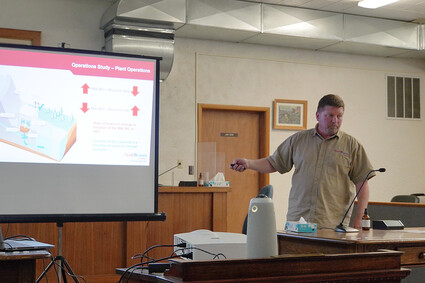Dam relicensing studies reviewed at meeting
June 1, 2023

Annie Wooden
Jeremy Clotfelter, director of hydro operations at NorthWestern, explains flexible capacity operations to residents at a community meeting for the Thompson Falls dam relicensing.
Community members met with NorthWestern Energy last week to hear updated reports on studies for the Thompson Falls hydroelectric project relicensing.
Results were detailed from the second year of studies examining hydraulic conditions, fish behavior, total dissolved gas, cultural resources, environmental justice and operations. Community members and other relicensing participants have until July 9 to submit comments on the updated study results. The study results and comments will be included in NorthWestern's relicensing application, a draft of which will be submitted to the Federal Energy Regulatory Commission (FERC) by August 8. The final license application will be submitted to FERC by December 31 of this year. According to NorthWestern's website, a final licensing decision is expected in the fall of 2025. The current FERC license expires in December 2025.
In the second year of the study in Thompson Falls, NorthWestern examined the effects of dam operations on fish, the environment, recreation and other factors. In the first year of the study, the company studied fluctuations in the water level up to 4 feet, as allowed in the current FERC license. In 2022, NorthWestern only studied adjusting the reservoir elevation within the top 2.5 feet. The impacts to the area, fish and other factors were minimal during the 2022 study. As such, NorthWestern in its relicensing application is proposing that the operations plan limit the raising and lowering of the water during operations to 2.5 feet instead of the current limit of 4 feet.
Eric Holmstead of GEI Consultants discussed the hydraulic conditions study, which evaluated how effective fish passage in the fish ladder at the Thompson Falls dam is at different flow rate. The data collected showed that at a lower rate of flow, more stream lines naturally go toward the fish ladder entrance, and at high velocities, fish are not going upstream to the dam and fish ladder, but at no point in the study was there an obstacle to fish passage. Jon Hanson, a fish biologist with NorthWestern, said that high velocities were not necessarily a complete barrier to fish. In the fish behavior study, rainbow and brown trout were tagged to study. Hanson said fish were caught upstream and from the fish ladder, then released downstream near the Flat Iron boat launch. In 2022, 53 of 54 tagged fish were detected in a zone outlined near the fish ladder, 72% traveled near the main channel of the dam above the natural falls, and about 40% actually entered the fish ladder. "Fish spent a considerable amount of time near the mouth of Prospect Creek," Hanson said as he explained graphics shown to the audience. "The high water temperatures in July and August influence fish behavior to stay near the mouth of Prospect." In spring 2023, a total of 30 rainbow trout were tagged and 11 of them have entered the fish ladder, Hanson noted.

Jeremy Clotfelter, director of hydro operations at NorthWestern, talked about the operations portion of the study. "The goal was to evaluate impact on project resources during flexible capacity operations with increases or decreases in generation of electricity," he noted. The study tested the boundaries of flexible capacity generation within the current license range of four feet. During both 2021 and 2022 studies, the test stayed within the top 2.5 feet of the reservoir. "Through two years of testing, the plant performed well, proving the plant has the ability to provide flexible capacity." He noted that the Thompson Falls dam bears 20% of the load of the company's 10 power houses in the state.
Other factors detailed in the operations study included shoreline stability, riparian habitats and fish trends such as fish getting stranded when water levels were lowered. The study results showed no significant impacts in any of those areas during the test operations. Hanson said that the fish ladder maintained full functionality at all times. Kim McMahon with Pinnacle Research studied the impacts on aesthetics and recreation. They monitored docks at the Cherry Creek boat launch and Wild Goose Landing Park, as well as 11 private docks. "Public access remained viable throughout the study, and the most significant impacts are on stationary docks," McMahon stated. She added that impacts to aesthetics were minimal in 2022 compared to deeper drawdowns in the 2021 study.
Jordan Tollefson is a water quality specialist with NorthWestern Energy and reviewed a total dissolved gas (TDG) study. TDG, he explained, is created by air mixing with the water when the dam is spilling. The study looked at ingoing and outgoing TDG. Different combinations of gates being opened at the main dam, inflows from 30,000 cubic feet per second to 85,000, were tested during the study. High levels of TDG can have negative effects on fish. Tollefson stated that the lowest levels of TDG were seen when gates were opened that were not adjacent to each other. "That's why they split the flow among different panels," he explained.
Ken Dickerson highlighted the cultural resources study, which was conducted to identify and determine historical significance of sites and develop a preservation plan. While there were 11 previously recorded cultural properties, Dickerson said the study revealed only six of those sites were located within the project area. NorthWestern is in the process of developing a historic properties management plan as part of the relicensing efforts. The environmental justice study looked at impacts of plant operations on low-income and minority populations. The study found that no populations exist in the project area that meet thresholds set in executive orders enforced by FERC. Consultant Mark Summer stated that the project has positive environmental, economic, recreation and community effects and that hydropower is a renewable energy that plays a key role in addressing climate change.
The updated study results, as well as information on how to submit comments, is available on NorthWestern's website, https://www.northwesternenergy.com/clean-energy/ hydropower/thompson-falls-hydro-project. To see any documents filed with FERC, go to FERC.gov, click on "eLibrary" and search by docket number P-1869 for the Thompson Falls project.



Reader Comments(0)